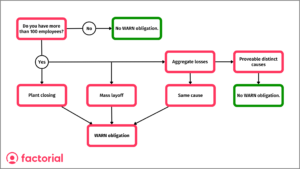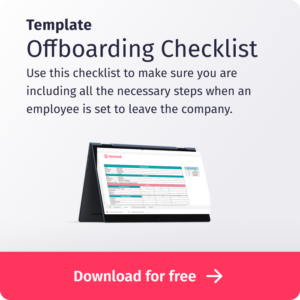The Worker Adjustment and Retraining Notification Act (WARN Act) is a crucial piece of legislation designed to protect employees and provide them with advance notice in the event of significant workforce changes. For HR managers, understanding the WARN Act is essential to ensure compliance and foster a transparent and fair working environment. In this article, we will explore the key aspects of the WARN Act and its implications for HR professionals.
TABLE OF CONTENTS
- What are the WARN Act Requirements?
- Who Does the Act Protect?
- What States Have the WARN Act?
- Minimum Number of Employees
- Layoff Requirements
- Layoff Rules
- Why is the WARN Act Important?
- Worker Adjustment and Retraining Notification Act of 1988 Purpose
- Offboarding employees during a layoff
- Offboarding w/ document management software ✅
What are the WARN Act Requirements?
According to the Act, covered employers must provide their employees with a 60-day notice in the form of a written notice letter before a plant closing or mass layoff. This notice period gives affected employees and their families enough time to plan for potential unemployment and find alternative employment opportunities. The act also requires employers to notify local government officials and the workforce development system of upcoming layoffs.
When must the WARN notice be given?
The WARN Act requires employers to provide notice to affected employees, their representatives, the local chief elected official (e.g., mayor), and the state dislocated worker unit at least 60 calendar days in advance of planned plant closings or mass layoffs. Employees and their families have time to prepare for the workforce changes. This 60-day notice period is intended to give employees and their families sufficient time to prepare for the loss of employment, seek alternative job opportunities, and, if necessary, participate in skill training or retraining programs.
It’s important to note that this notice period is a minimum requirement. Employers in all states are encouraged to provide notice as early as possible.
There are certain circumstances where employers may be exempt from the full 60-day notice requirement. For this, they must meet specific conditions outlined in the Federal WARN Act. These exemptions include situations where the layoffs result from unforeseeable business circumstances or where the employer is actively searching for capital or business that would allow the company to avoid or delay the layoffs.

What is a WARN notice?
Notification to individual employees must be presented in clear and precise language. The notice must provide all the necessary information about the closure or layoff, like specifying whether it is permanent or temporary. It must also indicate the date and location, and include the contact person within the company who can be contacted for further details. The notices provided to union representatives and government entities follow a similar format.
What happens if you violate WARN Act?
If an employer fails to notify the local government as outlined in the WARN Act, they can be fined up to $500 for each day they don’t provide the required notice. But, if the employer pays the amount they owe to each employee affected within three weeks after the closing, they can avoid this penalty.
What is a mass layoff?
A mass layoff is defined (under the WARN Act) as a situation where one of these criteria are filled:
- 500 employees: At least 500 employees lose their job during a 30-day period at a single employment site
- 50 employees: 50 employees are laid off (if the laid-off employees make up at least 1/3 of the workforce)
- 33% of the workforce: At least 33% of the workforce loses their jobs (excluding part-time employees) at a single employment site during a 30-day period.
These factors are used to determine whether a mass layoff triggers the WARN Act’s notification requirements. If either of these conditions is met, the employer is generally obligated to provide affected employees with a 60-day advance notice of the impending layoffs. Certain exceptions specified in the legislation do apply.
Does WARN Act apply to remote employees?
Although the WARN Act is quite vague on the subject, the Act can apply to remote employees if the remote location is considered part of a covered employment site facing a plant closing or mass layoff. Employers need to assess the overall impact of the layoff or closing on the workforce, including both on-site and remote employees. They need to determine if obligations specified in the law are triggered. Employers demonstrate compliance by providing affected remote employees with the required notice and informing relevant parties as specified by the Act.
Who Does the WARN Act Protect?
The WARN Act primarily protects employees who lose their job due to a plant closing or a mass layoff. A plant closing is the shutdown of a single employment site, resulting in job loss for 50 or more employees during a 30-day period. Mass layoffs involve job loss for at least 500 employees or 33% of the workforce at a single site during a 30-day period.
WARN Notice by State
While the federal WARN Act sets the basis for protection, some states have additional requirements or other regulations. Employers across the US need to be aware of both federal and state WARN act requirements to ensure that they demonstrate compliance. States such as California, New York, and Illinois for example have their own specific requirements that HR managers need to consider. These requirements are specified in the so-called mini-WARN Acts of these states.
What States Have the WARN Act?
The federal WARN Act sets standards for all US states, but not all US states have their own state-specific WARN requirements.
The following states have their own requirements, also known as mini-WARN acts: California, Connecticut, Hawaii, Illinois, Iowa, Kansas, Maine, Massachusetts, Michigan, Minnesota, New Hampshire, New Jersey, New York, Oregon, Rhode Island, South Carolina, Tennessee and Wisconsin.
States have their own WARN notice requirements to make sure regulations meet the needs of their unique economic and labor conditions. This allows for flexibility, better worker protection, and the ability to address specific challenges within each state’s jurisdiction.
Laws change, and it is important to keep up with changes to WARN law to stay compliant. Because of this, we recommend checking the official government websites of each state to keep up with Worker Adjustment and Retraining Notification Act-related news.
State WARN requirements by state
- Alabama WARN Laws
- Alaska WARN Laws
- Arizona WARN Laws
- Arkansas WARN Laws
- California WARN Laws
- Colorado WARN Laws
- Connecticut WARN Laws
- Delaware WARN Laws
- Florida WARN Laws
- Georgia WARN Laws
- Hawaii WARN Laws
- Idaho WARN Laws
- Illinois WARN Laws
- Indiana WARN Laws
- Iowa WARN Laws
- Kansas WARN Laws
- Kentucky WARN Laws
- Louisiana WARN Laws
- Maine WARN Laws
- Maryland WARN Laws
- Massachusetts WARN Laws
- Michigan WARN Laws
- Minnesota WARN Laws
- Mississippi WARN Laws
- Missouri WARN Laws
- Montana WARN Laws
- Nebraska WARN Laws
- Nevada WARN Laws
- New Hampshire WARN Laws
- New Jersey WARN Laws
- New Mexico WARN Laws
- New York WARN Laws
- North Carolina WARN Laws
- North Dakota WARN Laws
- Ohio WARN Laws
- Oklahoma WARN Laws
- Oregon WARN Laws
- Pennsylvania WARN Laws
- Rhode Island WARN Laws
- South Carolina WARN Laws
- South Dakota WARN Laws
- Tennessee WARN Laws
- Texas WARN Laws
- Utah WARN Laws
- Vermont WARN Laws
- Virginia WARN Laws
- Washington WARN Laws
- West Virginia WARN Laws
- Wisconsin WARN Laws
- Wyoming WARN Laws
WARN Act Minimum Number of Employees
The federal WARN Act applies to employers with 100 or more full-time employees, excluding those who have worked less than six months in the last 12 months or work an average of less than 20 hours per week. Part-time employees are also included in the calculation, with their hours aggregated to determine full-time equivalents.
Is a WARN notice required with a series of smaller layoffs?
WARN may be triggered in the case of a series of smaller layoffs, but it depends on the timing. Consecutive job losses within 90 days of each other will be aggregated and may require a WARN notice to be issued to employees. That is, unless the employercan prove that the job losses resulted from distinct causes and were not an attempt to evade the state’s WARN requirements.
Layoff Requirements
Employers covered by the WARN Act must provide affected employees with a written notice containing specific information, including the date of the planned action, reasons for the layoff, and information about employee rights. This notice should be given to affected employees, their representatives (such as unions), and appropriate government entities.
WARN Layoff Rules
The 60-day notice requirement is a central tenet of the WARN Act, but there are exceptions to this rule. Employers may provide less than 60 days’ notice if the layoffs result from unforeseeable business circumstances or if the employer is actively seeking capital or business, which, if obtained, would enable the company to avoid or postpone the layoffs.
How do companies protect themselves during a layoff?
There are three defenses provided under WARN that can create an exception to the full 60-day notice obligation. These are:
1. Faltering company
2. Unforeseen business circumstances
3. Natural disaster
Nevertheless, these defenses require careful consideration of the specific facts and should be discussed with legal counsel.
Why is the WARN Act Important?
The Act serves multiple purposes. Its primary purpose is to ensure that employees have sufficient time to prepare for losing their job and to give them the chance of finding an alternative place of employment. The act also encourages open communication between employers and employees. Compliance with the WARN Act is first and foremost a legal obligation, but it can also be seen as a strategic move for your organization to maintain a positive employer brand and positive employee relations.
Worker Adjustment and Retraining Notification Act of 1988 Purpose
The primary purpose of the Act is to provide workers and their families with transition time in the face of significant employment changes. By requiring employers to give advance notice of mass layoffs or plant closings, the act aims to mitigate the impact on employees’ lives. The act allows them to seek new employment, participate in retraining programs, and make informed decisions about their future. Visit the official DOL pages to read more about the act as an employer.
Offboarding employees during a layoff
Understanding the WARN Act is critical for HR managers and employers. Ensuring compliance with labor laws is one of your greatest responsibilities. Compliance ensures a fair and transparent process during significant workforce changes. Contribute to a positive workplace culture and maintain compliance with federal and state regulations by understanding the requirements set out in the WARN Act. HR software like Factorial helps you by streamlining your HR processes so you can save time on manual tasks and focus on more strategic ones, like being there for employees who need help.
How can Factorial help?
Factorial is your go-to for HR management. Now featuring document management and electronic signatures, it streamlines HR processes and facilitates easy, compliant request and recording of employee information. With Factorial’s user-friendly interface, employees can effortlessly request information. The platform ensures seamless record-keeping while adhering to regulations through its Employee Portal. Say goodbye to outdated methods and embrace HR software for simplified compliance. Factorial offers easy-to-use fillable forms integrated with its digital signature function. Customizable to your business needs, Factorial is your ally in navigating HR complexities. Schedule a demo to explore how it supports managing employee information and ensuring compliance!
Key Features for offboarding during layoffs:
1. Clear Communication: Easily communicate departure details to the departing employee, including the last day of work, return of company property, and other essential information.
2. Task Automation: Automate offboarding tasks, such as revoking system access, updating records, and notifying relevant departments, saving time and minimizing the risk of oversight.
3. Documentation and Compliance: Ensure compliance by generating necessary documentation, such as termination letters and exit surveys, helping you maintain a comprehensive record of the offboarding process.
4. Access Control: Centralize access control management, making it simple to revoke access to company systems and confidential information, safeguarding your organization’s data.
By utilizing Factorial for offboarding, HR managers can enhance efficiency, maintain compliance, and provide a positive experience for departing employees.





